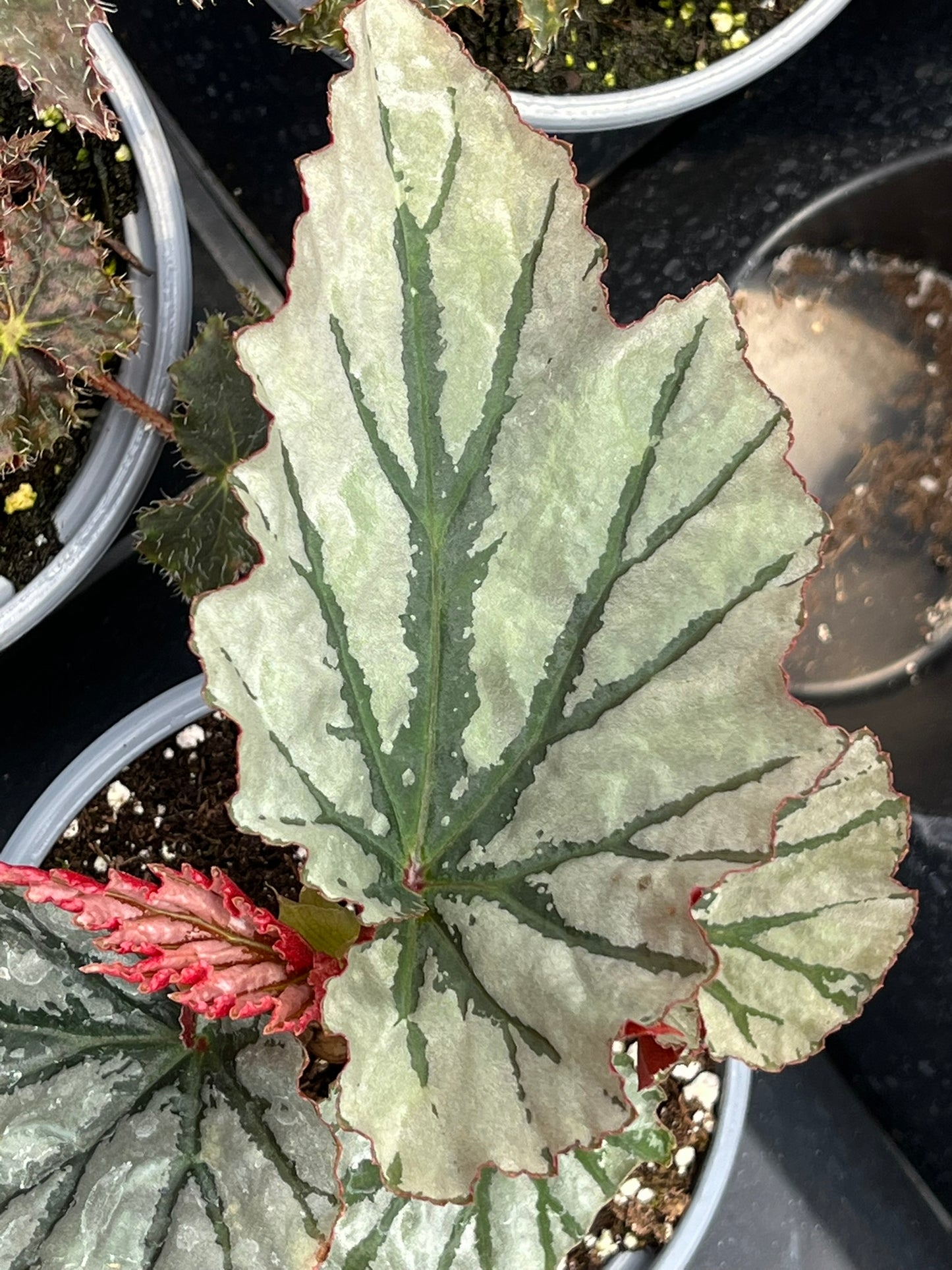Plant Hoarder
Begonia Looking Glass
Begonia Looking Glass
Couldn't load pickup availability
Share
Hardiness Zone:9
Sun Exposure:Part Sun, Mostly Shade and Shade
Begonia ‘Looking Glass’: A Silver-Leafed Showstopper for Shade and Indoors
Bold Foliage, Easy Care, and Dazzling Reflections of Garden Magic
Begonia ‘Looking Glass’ is a masterpiece in silver. This stunning cane begonia doesn’t whisper for attention—it demands it, with shimmering, metallic leaves that gleam like moonlight on water. If you’re looking for a plant that brings brightness to shady areas or indoor corners, this is it.
Whether you’re a collector of begonias or just diving into the world of foliage plants, ‘Looking Glass’ delivers both style and simplicity. It’s beautiful, bold, and surprisingly easy to grow—making it a must-have for gardeners of all levels.
Let’s explore how to grow, care for, and enjoy this one-of-a-kind begonia.
What Makes Begonia ‘Looking Glass’ So Special?
This begonia’s name says it all—it’s like looking into a silver mirror. It’s a type of cane begonia, known for its tall, upright stems and lush growth.
Key features that set it apart:
-
Silver Wonder Leaves: Large, oval-shaped leaves are silvery white with dark green veining. They shine and shimmer, especially in soft light.
-
Upright Growth: Strong, bamboo-like stems reach upward, creating vertical interest in pots or garden beds.
-
Soft Blush Blooms: It produces delicate pink flowers in clusters, usually in spring or summer, which dangle charmingly beneath the leaves.
-
Tropical Elegance: Adds a bright, exotic feel to shady gardens or interiors.
‘Looking Glass’ is the kind of plant that makes people stop, stare, and ask, “What is that?!”
How to Grow Begonia ‘Looking Glass’
This beauty isn’t hard to grow, but it does have some clear preferences. Get the basics right, and you’ll be rewarded with steady growth and glowing foliage.
1. Light Requirements
Begonia ‘Looking Glass’ prefers bright, indirect light. The more filtered light it receives, the more vibrant its silver coloring becomes.
-
Indoors: East or north-facing windows are perfect. West or south windows can work too, as long as there’s a sheer curtain.
-
Outdoors: Ideal in dappled shade or morning sun only. Harsh afternoon sun can fade or burn the leaves.
Want maximum shimmer? Keep it bright—but never direct.
2. Soil Mix
This begonia does best in a loose, fast-draining soil mix that retains some moisture but doesn’t stay soggy.
Ideal potting mix:
-
2 parts peat moss or coco coir
-
1 part perlite
-
1 part compost, aged bark, or orchid bark
Drainage is crucial! Always plant in containers with drainage holes.
3. Watering
Water when the top inch of soil is dry. The roots like even moisture but not sogginess.
-
Water thoroughly, letting excess water drain out
-
Never let the plant sit in water
-
Reduce watering in winter when growth slows
-
Water at the base to avoid splashing the leaves
Bonus tip: Use room-temperature water to avoid shocking the plant.
4. Humidity and Temperature
Begonia ‘Looking Glass’ loves warmth and humidity. Think tropical—but not sweltering.
-
Ideal temperature: 65–80°F (18–27°C)
-
Humidity: 50% or higher is best
-
Avoid: Cold drafts, dry air, and temperatures below 50°F (10°C)
Ways to boost humidity:
-
Group with other plants
-
Use a pebble tray or small humidifier
-
Place in a naturally humid room like a bathroom (if it has bright light)
Fertilizing for Best Results
This plant likes to be fed during its active growing season.
-
Use a balanced, water-soluble fertilizer (like 10-10-10)
-
Apply every 2–4 weeks, diluted to half strength
-
Stop feeding during winter when growth slows
If you notice lush leaves but few flowers, switch to a low-nitrogen, bloom booster formula.
Pruning and Maintenance
Begonia ‘Looking Glass’ is naturally upright and full, but a little pruning keeps it looking great.
-
Pinch tips to encourage branching and bushier growth
-
Remove dead or yellowing leaves regularly
-
Cut leggy stems back by 1/3 to encourage new growth (early spring is best)
-
Wipe dust off leaves to keep their silver shine
Propagation tip: Cuttings from this begonia root easily in water or moist soil.
Growing Indoors vs. Outdoors
This is a fantastic indoor plant, but it also thrives outside in warm climates.
Indoors:
-
Use decorative pots or tall planters to complement its upright habit
-
Rotate the plant every few weeks to ensure even growth
-
Keep it away from vents and heaters
Outdoors:
-
Perfect for patios, shaded gardens, or porch planters in USDA Zones 9–11
-
Treat it as a summer annual or container plant in cooler zones
-
Bring it indoors before temperatures fall below 50°F
Overwintering Indoors
Want to enjoy your ‘Looking Glass’ year-round? Here’s how to overwinter it indoors:
-
Bring it inside before the first frost
-
Place it in bright, indirect light
-
Trim back any long or leggy stems
-
Reduce watering and skip fertilizer
-
Resume full care in spring as growth resumes
Expect some leaf drop during adjustment—it’s normal.
Troubleshooting Common Issues
Even an easy-care plant has occasional needs. Here’s what to look for:
-
Crispy Leaf Edges? Usually low humidity. Increase moisture in the air.
-
Yellowing Leaves? Could be overwatering. Let soil dry a bit between waterings.
-
Pale Leaves or Faded Silver? Not enough light. Move to a brighter spot.
-
Drooping? Check the soil—it might be too wet or too dry.
-
Pests? Watch for mealybugs or spider mites. Treat with neem oil or insecticidal soap.
Why You’ll Love Begonia ‘Looking Glass’
This begonia is the ultimate foliage fantasy. It’s elegant. It’s unique. And it makes a bold statement without being fussy.
Here’s what gardeners and houseplant lovers adore about it:
-
Reflective, dramatic leaves that bring light to shade
-
Tropical elegance without high-maintenance care
-
Perfect for pots, containers, and patios
-
Compact and upright, ideal for small spaces
-
Easy to grow, even for beginners
Begonia ‘Looking Glass’ is more than just a plant—it’s an experience. It draws you in. It lights up a room. And it reminds us that even in the shadows, beauty shines the brightest.
Ready to add a little silver sparkle to your world? This is the one.


